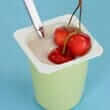Background
- Probiotics are beneficial bacteria (sometimes referred to as "friendly germs") that help to maintain the health of the intestinal tract and aid in digestion. They also help keep potentially harmful organisms in the gut (harmful bacteria and yeasts) under control. Most probiotics come from food sources, especially cultured milk products. Probiotics can be consumed as capsules, tablets, beverages, powders, yogurts, and other foods.
- Probiotics should not be confused with prebiotics. Prebiotics are complex sugars (such as lactulose, lactitol, a variety of fructo-oligosaccharides, and inulin) that are used as fuel by healthful bacteria to stimulate their growth and activity while suppressing the growth and activity of harmful organisms. Other foods that may support probiotic activity include Japanese miso, tempeh, kefir, raw milk, kombucha, bananas, garlic, and onions. When prebiotics and probiotics are combined in one product, it is called a synbiotic.
- Probiotics are thought to work by colonizing the small intestine and crowding out disease-causing organisms, thereby restoring proper balance to the intestinal flora. They compete with harmful organisms for nutrients and may also produce substances that inhibit growth of harmful organisms in the gut.
- Probiotic bacteria have been found to stimulate the body's immune system. They may also aid in several gastrointestinal illnesses such as inflammatory bowel diseases, antibiotic-related diarrhea, Clostridium difficile toxin-induced colitis, infectious diarrhea, hepatic encephalopathy, irritable bowel syndrome, and allergies.
- Probiotics have been found to enhance the digestion and absorption of proteins, fats, calcium, and phosphorus. They may also help overcome lactose intolerance and restore healthful bacteria after a course of antibiotic therapy has altered the normal gastrointestinal flora.
References
Natural Standard developed the above evidence-based information based on a thorough systematic review of the available scientific articles. For comprehensive information about alternative and complementary therapies on the professional level, go to . Selected references are listed below.
- Ataie-Jafari, A., Larijani, B., Alavi, Majd H., and Tahbaz, F. Cholesterol-lowering effect of probiotic yogurt in comparison with ordinary yogurt in mildly to moderately hypercholesterolemic subjects. Ann.Nutr.Metab 2009;54(1):22-27.
View Abstract - Bin-Nun A, Bromiker R, Wilschanski M, et al. Oral probiotics prevent necrotizing enterocolitis in very low birth weight neonates. J Pediatr 2005 Aug;147(2):192-6.
View Abstract - Delia P, Sansotta G, Donato V, et al. Use of probiotics for prevention of radiation-induced diarrhea. World J Gastroenterol 2007 Feb 14;13(6):912-5.
View Abstract - Gilboa Y, Bar-Hava I, Fisch B, et al. Does intravaginal probiotic supplementation increase the pregnancy rate in IVF-embryo transfer cycles? Reprod Biomed Online 2005 Jul;11(1):71-5.
View Abstract - Hatakka K, Ahola AJ, Yli-Knuuttila H, et al. Probiotics reduce the prevalence of oral candida in the elderly--a randomized controlled trial. J Dent Res 2007 Feb;86(2):125-30.
View Abstract - Hatakka K, Blomgren K, Pohjavuori S, et al. Treatment of acute otitis media with probiotics in otitis-prone children-a double-blind, placebo-controlled randomised study. Clin Nutr 2007 Jun;26(3):314-21.
View Abstract - Kajander K, Hatakka K, Poussa T, et al. A probiotic mixture alleviates symptoms in irritable bowel syndrome patients: a controlled 6-month intervention. Aliment Pharmacol Ther 2005 Sep 1;22(5):387-94.
View Abstract - Larsson PG, Stray-Pedersen B, Ryttig KR, et al. Human lactobacilli as supplementation of clindamycin to patients with bacterial vaginosis reduce the recurrence rate; a 6-month, double-blind, randomized, placebo-controlled study. BMC Womens Health 2008 Jan 15;8:3.
View Abstract - Marteau P, Lemann M, Seksik P, et al. Ineffectiveness of Lactobacillus johnsonii LA1 for prophylaxis of postoperative recurrence in Crohn's disease: a randomised, double blind, placebo controlled GETAID trial. Gut 2006 Jun;55(6):842-7.
View Abstract - McClave SA, Chang WK, Dhaliwal R, et al. Nutrition support in acute pancreatitis: a systematic review of the literature. JPEN J Parenter Enteral Nutr 2006 Mar-Apr;30(2):143-56.
View Abstract - Michail SK, Stolfi A, Johnson T, Onady GM., Efficacy of probiotics in the treatment of pediatric atopic dermatitis: a meta-analysis of randomized controlled trials., Ann Allergy Asthma Immunol. 2008 Nov;101(5):508-16.
View Abstract - Mukerji, S. S., Pynnonen, M. A., Kim, H. M., Singer, A., Tabor, M., and Terrell, J. E. Probiotics as adjunctive treatment for chronic rhinosinusitis: a randomized controlled trial. Otolaryngol.Head Neck Surg. 2009;140(2):202-208.
View Abstract - Sazawal S, Hiremath G, Dhingra U, et al. Efficacy of probiotics in prevention of acute diarrhoea: a meta-analysis of masked, randomised, placebo-controlled trials. Lancet Infect Dis 2006 Jun;6(6):374-82.
View Abstract - Szajewska H, Skorka A, Dylag M. Meta-analysis: Saccharomyces boulardii for treating acute diarrhoea in children. Aliment Pharmacol Ther 2007 Feb 1;25(3):257-64.
View Abstract - Underwood, M. A., Salzman, N. H., Bennett, S. H., Barman, M., Mills, D. A., Marcobal, A., Tancredi, D. J., Bevins, C. L., and Sherman, M. P. A randomized placebo-controlled comparison of 2 prebiotic/probiotic combinations in preterm infants: impact on weight gain, intestinal microbiota, and fecal short-chain fatty acids. J Pediatr.Gastroenterol.Nutr. 2009;48(2):216-225.
View Abstract







